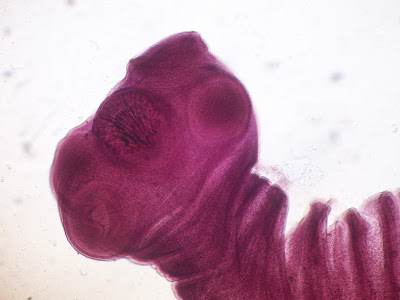Life Cycle and pathogenicity of Wuchereria bancrofti
Life Cycle and pathogenicity of Wuchereria bancrofti
Classification-
Phylum- Nematoda
Class- Phasmida
Order- Filaroida
Genus- Wuchereria
Species- bancrofti
Wuchereria bancrofti is commonly known as filarial worm. This worm causes filariasis in humans.The name of this worm is given Wuchereria bancrofti in honor of the two scientists Wucherer and Bancroft who made considerable contribution in studying the disease caused by these worms.
LIFE CYCLE OF WUCHERERIA
Wuchereria is a heterogeneous parasite which completes its life cycle in two different hosts namely man and female culex mosquito.
Life cycle in Man-
This cycle is also known as Human Phase. The process of copulation takes place in the lymphatic system of the human. The male and female worms copulate when they are present in the same lymph gland. The female worms are ovoviviparous that is they produce eggs which hatch within the body of the female without obtaining nourishment from it. Numerous microscopic juvenile larvae called microfilariae are released into the lymph.Each microfilaria is about 0.2 to 0.3 mm in length. It is surrounded by loose cuticular sheath. This cuticular sheath is also known as egg membrane. The surface of this larva is covered by flattened epidermal cells. Its body contains columns of cytoplasm with a number of nuclei.
The microfilaria after being released into the lymph vessels, enter the blood vessels and circulate with the blood. Ultimately they migrate to the visceral organs and reside in the deeper blood vessels of thorax region. In this thorax region the larvae do not undergo any additional change as further development can happen only inside the intermediate host (mosquito). Thus, these larvae move to the peripheral blood vessels during the night time between 10:00 pm to 4:00 am to suit the feeding habit of the mosquito. This movement of the larvae is called as nocturnal periodicity. During the day time these larvae live in the large deep-seated blood vessels but during night they migrate to the peripheral blood vessels. Hence it can be said that microfilariae show day and night periodicity also known as diurnal rhythm. The microfilariae die if they are not transferred to the mosquito within 70 days. This microfilaria is the infective stage to the mosquitoes.
Life cycle in Mosquito-
This cycle is also known as Mosquito Phase.When the female culex mosquito sucks the blood from the Wuchereria-infected person, the microfilaria from the peripheral blood, enter the midgut of the mosquito. In the midgut thy shed their protective sheath within 6 hours. After shedding the sheath they penetrate the stomach wall and migrate to the thoracic muscles where they metamorphosis and grow. Initially they metamorphose into a flat sausage-shaped larva also called as first-stage larva. Later this larva undergoes first moulting and grows into a slender elongated second-stage larva. Finally this second stage larva undergoes second moulting transforming into a long infective stage also called as the third-stage larva. All these changes take place within 10-20 days. The final third-stage larva moves to the labium of the mosquito so that it can be transferred to the definitive host (man).
In man the filarial larva first enters the blood circulation through the bite of the mosquito and then it enters into the lymphatic vessels where it undergoes third and fourth moulting and transforms into adult. The adult male and female worms copulate and the female delivers microfilariae.
Diagnosis-
he diagnosis includes the study of microfilariae after staining. Microfilariae of different species are identified based on their specific shape and morphological characters.
Therapy and control-
Complete satisfactory treatment is not yet known though the disease can be reduced or eliminated by eradication of microfilariae from the circulation by administration of heterazan and compounds of antimony and arsenic.





Comments
Post a Comment